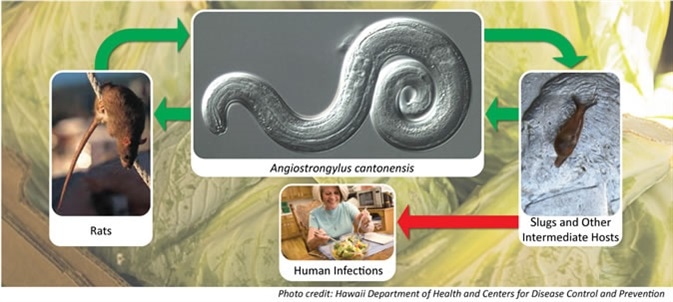The best way to prevent Rat Lungworm Disease (RLWD) is to be proactive. The more steps are taken to lower the risk factors, the less likely we are to become infected by it.
Awareness helps in understanding more about the disease and to be cautious. Discussing with family, friends, and acquaintances about the facts of RLWD will keep us up-to-date.
A Facebook page (https://www.facebook.com/Rat-Lungworm-Working-Group-339051019503614/) serves as a forum for discussion about RLWD. Educating children and visitors about preventive techniques will stop the spread of the disease as individuals, family and pets, and the community—all of these will play a role in preventing RLWD.

Following CCC – Check, Clean, Cook
Slugs and snails leave coiled feces in vegetables and fruits and damage the leaves or create cavities in the produce. If there is evidence of slime trails on produce, one should avoid buying them. In the case of windfallen fruit, while picking up from the ground, one should inspect carefully, as they could be infected by semi-slugs. Avoid buying vegetables and fruits with broken or damaged skin, as they are difficult to wash properly.
Use a vegetable brush and cleanse the surface of vegetables and fruits. The chances of larval infection are greater in some vegetables and fruits, for example, leafy vegetables such as lettuce and cabbage. Split the leaves, check each one of them, and discard them if there are proofs of slugs or snails. Use clean, safe, potable water to wash the raw produce before storing in the refrigerator.
Before cooking food, wash hands with soap and water. Using boiling water to clean the produce reduces the risk of infection. Paratenic hosts, such as frogs and freshwater prawns, can also be infected with the larvae. While steaming reduces the danger of infection, when food is cooked, the larvae are killed and the threat of infection is eliminated.
Cooking to 165° F and freezing for 24–48 hours before consuming the food is ideal. Some people have noted that the taste of the snail or slug is disgusting. When you bite food, if the taste is malicious, immediately spit the food.
Since the parasite can quickly enter the central nervous system and cause infection to the brain, rinse your mouth thoroughly and spit again to avoid infection. Covering the food will avoid crawling of snails or slugs into the food.
Using filtered water for drinking and for other household purposes such as brushing teeth or bathing is recommended, as using catchment water is risky when infected snails and slugs fall into them. Covering the catchment tank and maintaining a regular schedule to replace catchment water filters and UV sterilization system will ensure RLWD-free water.
Controlling Definitive Hosts
Maintaining good sanitation continuously is vital to control definitive hosts such as rats. Cleaning leftover food particles and debris, removing pipes, wooden logs, and other equipment, a systematic schedule to trim the vegetation, and cleaning the gutters will control the rat population. While traps are useful indoors, toxic baits and pest control techniques can be employed outdoors. Rodent proofing buildings is the most successful technique and is a long-lasting method of rat control.
Controlling Intermediate Hosts
Snails and slugs reside in moist places and are active during the night. Adopting drip irrigation techniques will reduce moist surfaces and keep the pests away. Gardens can also be located far away from places where snails and slugs hide. If it is not possible to eliminate the hiding place, bait traps are ideal. Inverted melon rinds can serve as traps.
Fruits such as strawberries and avocados that are close to the ground surface are vulnerable. In contrast, plants like fuchsias, lantana, geraniums, ornamental plants, grasses, plants with stiff leaves and woody, aromatic plants such as lavender and rosemary are snail repellent. When the garden is designed using these plants, damage due to snails and slugs may be reduced.
When the snail and slug population is reduced, then handpicking them will be sufficient. The pests can be picked up using gloves and immersing in soap water or spraying a solution of pesticide will kill them.
Physical Barriers
Copper screens are effective physical barriers as they react with the slime of the snails and slugs and create shock, disrupting their nervous system. Tall copper screens can be erected and a few inches of the screens can be buried in the soil to prevent crawling of the snails and slugs beneath the copper barrier.
Copper foils can be used to wrap planting boxes and trunks. Checking for snails and slugs and removing them will help to make the box pest-free for planting new plants. To kill the eggs in the raised bed, the best method is to solarize the soil.
Alternatively, a mixture of copper sulfate and hydrated lime mixture, bordeaux mixture, can be used to brush the trunks to prevent snails.
Sources
- http://www.ipm.ucdavis.edu/PMG/PESTNOTES/pn7427.html
- http://ipm.ucanr.edu/PMG/PESTNOTES/pn74106.html
- pharmacy.uhh.hawaii.edu/rlw/documents/RLWDRiskReduction.doc
- http://www.hawaii.edu/cowielab/2%20Kim%20Angio%20Workshop.pdf
- https://www.ncbi.nlm.nih.gov/pmc/articles/PMC3689498/
- manoa.hawaii.edu/…/Prevent-RLWD-In-the-kitchen-041717.pdf
- https://www.ctahr.hawaii.edu/oc/freepubs/pdf/FST-39.pdf
Further Reading
- All Rat Lungworm Disease Content
- How is Rat Lungworm Disease Spread?
- Rat Lungworm Disease in Hawaii
- Rat Lungworm Disease Research
- Symptoms of Rat Lungworm Disease
Last Updated: Apr 11, 2019

Written by
Afsaneh Khetrapal
Afsaneh graduated from Warwick University with a First class honours degree in Biomedical science. During her time here her love for neuroscience and scientific journalism only grew and have now steered her into a career with the journal, Scientific Reports under Springer Nature. Of course, she isn’t always immersed in all things science and literary; her free time involves a lot of oil painting and beach-side walks too.
Source: Read Full Article
